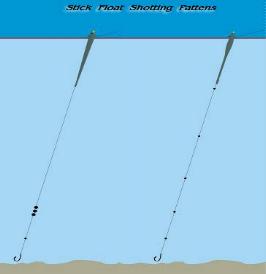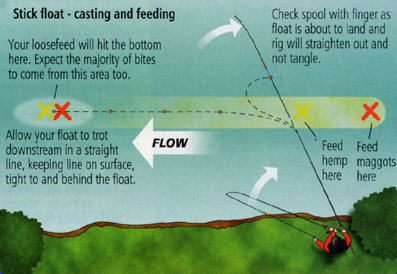STICKFLOATS
Stickfloats are just one of a group of floats that are specifically designed for use on running water that are fixed to the line with 2 or 3 little bands of rubber ,two thin ones and a longer one place one of the thin ones at the top just below the tip , the longer one is placed at the bottom of the stem and is fitted so half is on the stem and some is pretuding of it to help prevent tangles and sometimes another thin float rubber is put up the stem to act as a spare bottom and to secure the line to the body of the float . running water floats which include the following types :-StickFloats , Chubbers , loafers , Avons & trotters. Each type and veriety of float is idealy suited to different river conditions and situations and can be made of a veriety of materials.
Visiting a tackle shop to buy floats can be very confusing as not only are they available in a range of sizes and materials, there are a multitude of different patterns available.These naturally come in a whole range of lengths and diameters creating the problem as to which float is the best buy. Unfortunately there is no simple answer; it depends on the venue being fished, conditions, and the range and distance being fished .
Starting with size or shot carrying capacity, you will need a float which carries enough shot to easily reach the swim. I stress "easily" as when you get tired the last thing you want is to struggle to cast to your swim. I have seen many anglers start off well from a swim and then lose the fish as they have got tired and can't reach the swim. They are falling short of the feed that they had placed further out when they'd started. As regards thickness, the thinner the float tip, the more sensitive it is and the more easily it will be to pull under. However there are times, like when fishing a flowing river, when we do not want a float that is too easily dragged under by either turbulence or the float dragging the bait across the bottom.
SETTING THINGS UP
After you've threaded the line through the rods rings slip three small rubber bands onto the line ,two thin ones and a longer one then you place one of the thin ones at the top just below the tip ,push the stem of your stickfloat into the other float rubbers , the second thin float rubber is put up the stem to act as a spare bottom and to secure the line to the body of the float then the longer one is placed at the bottom of the stem and is fitted so half is on the stem and some is pretuding of it to help prevent tangles .then slide the whole lot up the line to ware you guestimate the depth of the river to be then put a small leadfree shot below the bottom float rubber so the float sits on this shot and it can act as a depth marker then you choose which shotting patten to use either a bulk one or a strung out patten between float and hook.

Shotting Pattens
For running water float rigs there is mainly only two choices either :-
BULK SHOT PATTEN
a bulk shot or olivete is placed two thirds down from your float with a couple of dropper shots closer to the hook to sink the bait much more quickly.
STRUNG OUT PATTEN (Shirt Button Style)
After your marker shot(under the float) There are literally thousands of ways of arranging the other remaining few shots down the line but I am only going to give you one arrangement in this feature. I know this shotting pattern works in the majority of cases. It is simple yet very effective.

Casting Techniques
Casting techniques all depend on what type of fishing reel you are to be useing.
SIDEWAYS SWING CAST
Let the float/rig hang about 3-4 foot from the tip at a angle 45 deg upwards this is swung out in a 90 deg ark cast out towards the swim. Once your forefinger has released the line, keep it close to the spool ready to feather the line down (In feathering the line all you need do is to tap the spools lip with your forefinger to slow the speed of the line leaving the spool), slowing the float down and allowing the shot to overtake the float so that the hook lands in front of the float.the flow of the river will pull your tackle strait and so avoid tangles , leave your bail arm open / dissengaged so the line can peel off as your float trotts down the river you control the rate at which line flows from your reel by either dabbing the rim / spool with your finger or by pulling line off with your spare hand or letting it run over a crocked forefinger and applying tention to the line between reel and first rod ring . once the rig is in the water it may become necasary to mend the line so it follows the float down your swim and dosen't pull the float of curse.

Striking And Straitening The Line
STRAITENING THE LINE
After casting out if a bow is allowed to form in the line any breeze is sufficient to pull your float away from the feed and off line. we solve this problem by picking up any slack off the surface of the river and flick it over so it falls back in line behind your float allowing it to trot down the river.
STRIKING
When your float goes under simply trap the line with your finger against the rim or spool of your reel or against your rod if your running line over a crocked finger and if you are fishing close in , a lift will be sufficient to set your hook but if you are fishing further out , a good sweep is more effective. This is because you are not wasting energy on lifting the line out of the water and sometimes the pull of the fish in the flow of the water is sufficient to be self hooking.
Copyright © 2006 Steven Devereux. All Rights Reserved.
